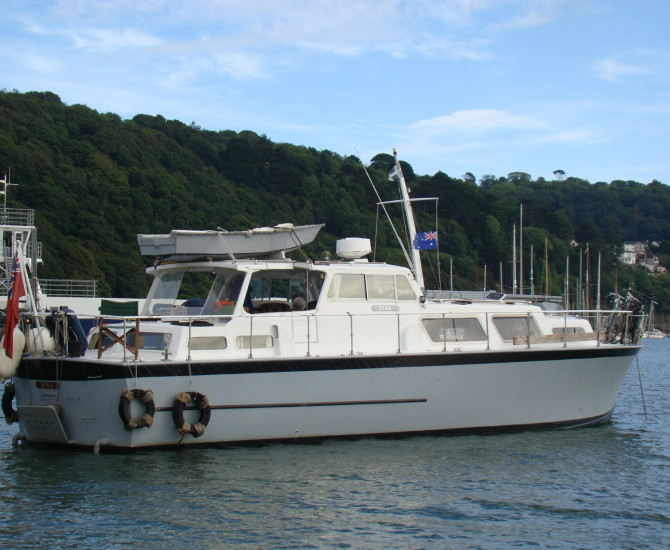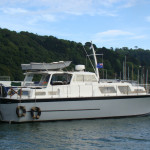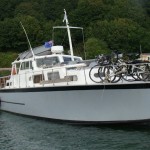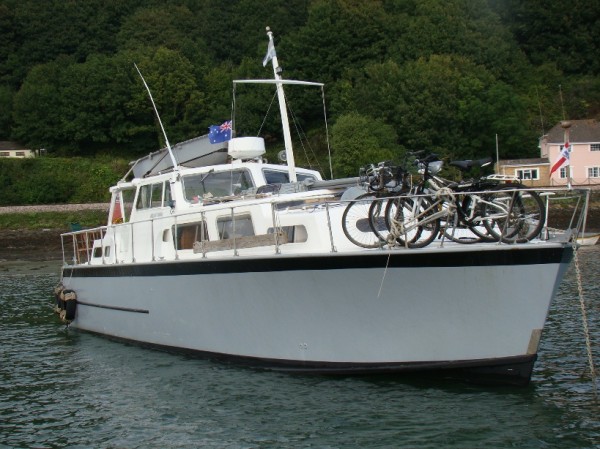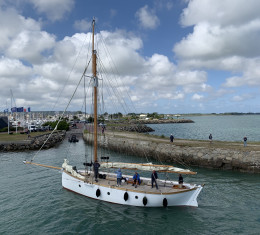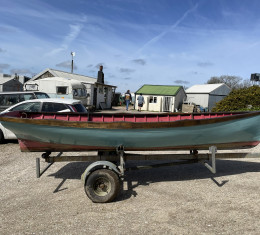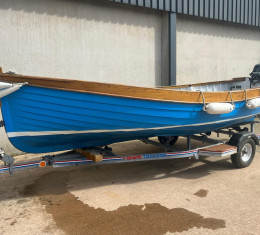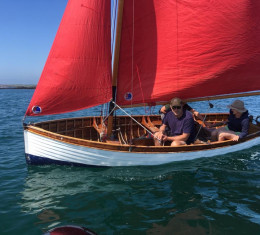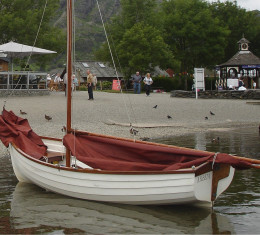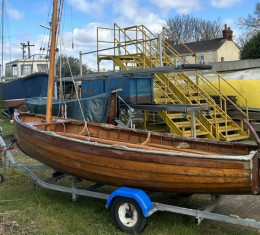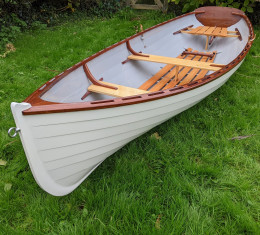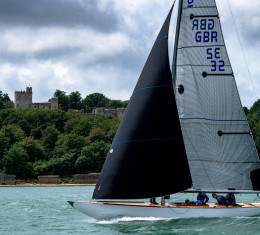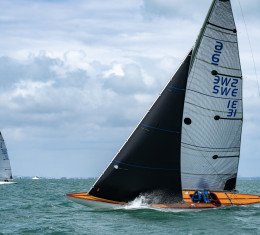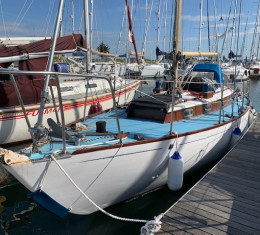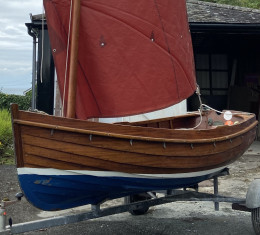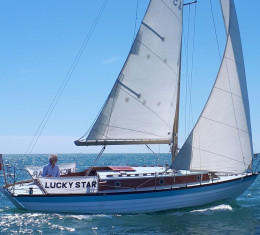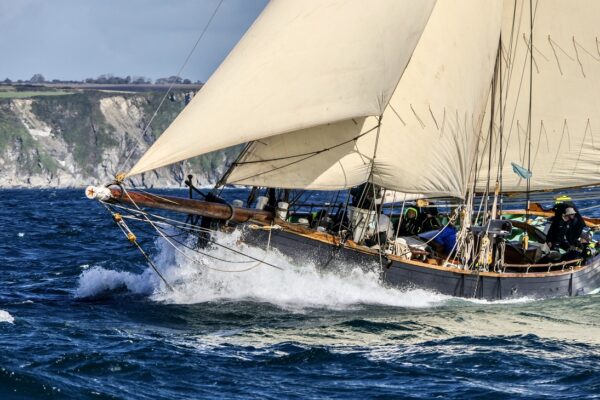Motor yachts
Full specification
Wooden ships comments on this Osborne twin screw motor yacht
, designed and built by Osbornes of Littlehampton in 1962.
A semi planing, hard chine hull form with long keel. This hull form presents lower drag and greater stability in a cross sea than a conventional round bilge design.
Radiused transom stern with fold-up boarding platform. High freeboard.
The vessel carries her beam almost the full length of the hull to give remarkable internal volume for her dimensions.
The vessel has a top speed of 12knts, the allure of a gun boat and she really does go.
The vessel was owned in Salcombe for some years having been bought on the Isle of Wight and regularly cruised the south coast and Britanny.
Sold by Wooden Ships to the present Australian/English ownership in 2006, she had a thorough refit to prepare her for her new very active life. Since then she has cruised along the south coast and up the east coast, across to Holland and Germany and round the western and German Baltic. She then went into the European canal system where she explored extensively for several years before returning to Devon in August 2011 and being laid up ashore for sale.
This has been an extraordinarily successful boat in the hands of both the previous and current owners, the boat has always performed perfectly in all weathers at sea and on inland waters.
At sea she has a max speed of 12knts and will cruise comfortably at 10knts even in lumpy conditions with 8.5knts as her most economical speed. She has a remarkably gentle, stable motion in open waters and in inland waters has provided an ideal cruising home for long periods.
At 1500rpm with both engines she will do 8.5knts with a consumption of 1.5litres per mile per engine.
On the inland waters, 1500rpm gives her 6.5knts making her very economical.
Construction.
Double diagonally planked mahogany hull skin with calico and white lead between. A recent core removed for a new hull fitting revealed the timber in perfect condition and is on display on board to reassure those sceptics who have concerns over this method of construction which gives greater strength for weight than conventional carvel planking and a totally water-tight hull.
The two mahogany layers are through copper riveted at close intervals and the whole fastened to web ribs in the flat surface topsides with steam bent timbers in the slightly rounded bottom sections.
The long oak keel forms an elongated fin aft to assure directional stability, cutting away in line with the props and just enough to protect the props should the vessel lie aground.
Twin small bronze spade rudders on rod and gear steering from the teak spoked wheel.
In the 2006 refit all bronze through hull fittings removed and checked.
Steps fitted up the transom with a fold-up bathing platform.
The deck is built in teak on a marine ply sub deck. In previous ownership, occasional leaks were a nuisance and in the 2006 refit after purchase by the present owner the deck and superstructure were sensibly covered in epoxy glass. While this may offend the purist, it has the net effect of making the boat totally water-tight, reducing maintenance and ensuring a long life by keeping the water out.
The superstructure has a centre bridge position with excellent all round visibility. An aft casing covers the aft cabin, immediately forward of the bridge is the coach-roof over the saloon cabin stepping down to the forward coach-roof over the fore cabin.
This leaves a fore deck with ample space to work, quite narrow side decks yet still very adequate to allow fore and aft passage and a good aft deck to work the stern lines.
Railings all round on stainless steel stanchions with teak capping and grab rails along the superstructure ensure security on deck.
Stanchions removed for the sheathing and replaced with new bolts and pads
In the refit, 11 new alloy hatches were fitted to the deck and coach-roof deck to give extra ventilation
The midships bridge position is accessed from each side, stepping down onto a box/seat step in the cock-pit. Drop in wash board each side.
The cock-pit sole is at a lower level than the main deck, teak laid with two large lifting hatches to give excellent access to the engine bay below.
In the refit, the wheel-house roof was extended aft to cover the cock-pit, an acrylic window fitted down onto the after coach-roof and ingenious acrylic fold-away removeable windows to close off the side entrances. With all closed down, only minimal heat is required even in the winter to keep the boat snug. Being Aussies, the usual source of cabin heating is the portable BBQ!
Traditional teak spoked wheel to port with the control console and engine Morse controls.
A comfortable helmsman’s seat on a raised platform stowage box.
Chart desk to stbd.
The original drop-leaf mahogany saloon table is now fitted in the cock-pit with seating for 6 making it the most popular living area on the boat
Fold down mast on the saloon cabin coach-roof.
Folding crane on the aft deck to lift a dinghy out of the water onto the roof.
Machinery.
Twin, handed, GM 4-cyl 120hp 2-stroke diesels with GM hydraulic gear-boxes on long timber engine beds, sited under the cock-pit sole with excellent all round access.
Conventional shaft drive to 3-blade bronze props carried on bronze A brackets
These are believed to be the original engines, their performance is quite remarkable, total lack of vibration, very acceptable noise levels that allow normal conversion in the wheel-house and all very clean with drip trays under the engines.
Exhaust outlets in the transom fitted with elbow pipes to give muffled exhaust exit just under the waterline.
Fuel.
850 litres of diesel in 4 tanks. In the refit the original steel fuel tanks in the engine bay were replaced with 3 rigid plastic fuel tanks allowing visual check of levels, 150 litre tanks each side with a central 300 litre tank and the original 250 litres steel reserve fuel tank forward under the fore cabin sole.
The tanks are inter-linked through a valve chest allowing both engines to draw from all tanks as required.
Gravity feed to the engines from the wing tanks.
2 x 12v transfer pumps.
Max speed 12knts
Cruising speed 9knts
On in inland waterways, 8.5knts with both engines running at 1500rpm gives 1.5litres per mile per engine.
1500rpm on one engine gives 6.5knts on inland waterways.
The batteries are sited between the engine beds, low down on the centre-line with a lid to form
the step down into the engine bay.
2 x 12v engine start batteries
2 x 12v domestic batteries new 2011.
Sterling smart battery charging with 240v shore power connection.
Parallel switch allows charging batteries when running on either engine only.
1000Watt 12v – 240v invertor.
Accomodation.
6 berths.
Forward cabin with port and stbd berths reaching forward under the fore deck with an infill to
form a large comfortable berth taking advantage of the width forward. Good standing head-
room under the fore end of the coach-roof.
Porcelain hand basin with cupboard under against the bulkhead to stbd.
Bulkhead door to the athwartships galley.
To starboard, stainless steel sink and drainer against the bulkhead with:
New stainless steel 2-burner grill and oven gas cooker, fixed with fiddle rails.
To port, a work surface with shelves/cupboard on the bulkheads and
New 12v fridge under.
New gas instant water heater on the fwd bulkhead supplies galley and heads compartment.
Port bulkhead opened to form a serving hatch into the saloon which has transformed the galley opening it to the saloon.
Webber gas BBQ
Gas alarm and auto-shut-off.
2 x 11kg propane gas bottles in sealed locker aft, vented overboard with remote shut-off in the saloon cabin.
Bulkhead central door to the saloon cabin. Seating to port:
Seating altered to convert to double berth with privacy curtain
Heads compartment in the after port corner with sea toilet, porcelain hand basin on a varnished mahogany locker and shower. Teak grating over shower tray.
The saloon cabin table is currently carried in the wheelhouse area. Pair of matching arm chairs. Lockers under the stbd side deck. Desk and bulkhead booze cupboard in the after stbd corner. Half height locker in the forward stbd corner.
This saloon cabin is a light, airey cabin with a feeling of open space, good visibility out of the windows all round all of which have been refitted and are water-tight.
Steps up to the wheel-house.
Lifting centre-line sections to access the engine space below.
Wheel in the forward port corner with comfortable helmsman’s seat gives good all-round visibility.
Chart desk to stbd.
Seating down the stbd side. The saloon table is usually carried here as the wheel-house makes a very good living area in warm climates.
Wheel-house roof extended aft to cover the whole area with removeable side panels and after panels in Perspex.
Dinghy stows on the roof with robot derrick arm on the aft deck to lift it on board.
Center-line entrance aft and steps down to the aft cabin with generous port and stbd berths.
Heads compartment in the forward stbd corner with sea toilet, porcelain hand basin and shower, drains into a shower tray with auto-pump out overboard.
Hanging locker in the forward port corner, good stowage in drawers under the berths and lockers under the side decks.
Large lazarette aft with generous stowage.
Compass
Radar
Coursemaster auto-pilot (new 2009)
VHF radio
Brookes and Gatehouse sounder
Horn (new 2010)
Spotlight
Ground tackle
Lofrans Tiger 12v windlass,(new 207)
2 x 30lb CQR anchors
1 x 15lb Admiralty pattern anchor
30 meters 3/8” galvanised chain
50 meters nylon warp
Safety equipment
MOB retrieval sling
6 x inflatable life jackets (new 2007)
Life buoy
Stern boarding platform and transom steps
Stripper rope cutters on the shafts
1 x 240v submersible crash pump, (new 2006 unused)
2 x 12v bilge pumps
Deck equipment.
Spotlight
4 x 25 meter mooring lines.
Ample fenders and assorted warps.
Owner comment:
Sona has travelled many miles in the 5 years we have owned her. She has proved ideal. She is easily handled in close situations, is dry below and provides traditional spaciousness. She has been reliable and economical to maintain. In short an ideal vessel for coastal and inland exploration. A number of passages have been single handed.
Wooden Ships comment:
The owners are no longer able to spend time on board in UK so she really has to find a new owner this winter. Please do not hesitate to get in touch with us.
Disclaimer:
These particulars have been prepared in good faith from information provided by the Vendors and are intended as a guide, Wooden Ships cannot guarantee or warrant the accuracy of this information nor warrant the condition of the vessel. The Purchaser should instruct his agent or surveyor to validate all details as necessary and satisfy himself with the condition of the vessel and its equipment.
Wooden Ships classic yachts brokers have an extensive database of boats for sale. With a wide range of sailboats, classic yachts, motor yachts and small classic boats, Wooden Ships has one of the largest selections of traditional wooden boats and yachts for sale in the UK.
Disclaimer:
These particulars have been prepared in good faith from information provided by the Vendors and are intended as a guide, Wooden Ships cannot guarantee or warrant the accuracy of this information nor warrant the condition of the vessel. The Purchaser should instruct his agent or surveyor to validate all details as necessary and satisfy himself with the condition of the vessel and its equipment.

